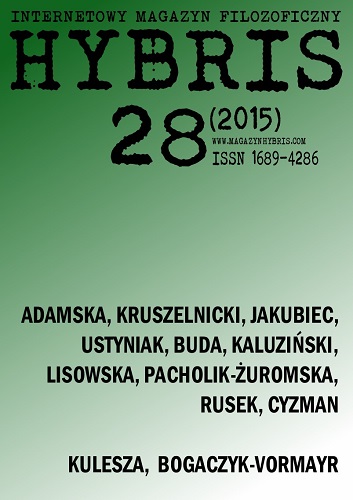Can we build theories of understanding on the basis of mirror neurons?
DOI:
https://doi.org/10.18778/1689-4286.28.08Słowa kluczowe:
mirror neurons, understanding, intentionality, self-reflection, concepts, self-knowledgeAbstrakt
The discovery of mirror neurons and the characterization of their response properties is certainly an important achievement in neurophysiology and cognitive neuroscience. The reference to the role of mirror neurons in ‘reading’ the intentions of other creatures and in the learning process fulfils an explanatory function in understanding many cognitive phenomena beginning from imitating, towards understanding, and finishing with complex social interactions. The focus of this paper is to review selected approaches to the role of mirror neurons in mental activity as understanding, and to conclude with some possible implications for researches on mirror neurons for philosophical theories of understanding.
Bibliografia
Brentano, F., 1874, Psychology from an Empirical Standpoint, trans. A.C. Rancurello, D.B. Terrell and L.L. McAlister, London: Routledge & Kegan Paul, 1973.
Zobacz w Google Scholar
Davidson D., 1999, The Emergence of Thought, “Erkenntnis”, 51(1999), 7–17.
Zobacz w Google Scholar
DOI: https://doi.org/10.1023/A:1005564223855
Davidson, D., 2001, Rational Animals, (in:) Subjective, Intersubjective, Objective, New York: Clarendon Press.
Zobacz w Google Scholar
DOI: https://doi.org/10.1093/0198237537.001.0001
Di Pellegrino, G., Fadiga, L., Fogassi, L., 1992, Understanding motor events: A neuropysiological study, “Expermental Brain Research” 91.
Zobacz w Google Scholar
DOI: https://doi.org/10.1007/BF00230027
Erlhagen, W., Mukovskiy, A., & Bicho, E., 2006, A dynamic model for action understanding and goal-directed imitation. “Brain research”, 1083(1), pp. 174–88. doi:10.1016/j.brainres.2006.01.114
Zobacz w Google Scholar
DOI: https://doi.org/10.1016/j.brainres.2006.01.114
Evans, G., 1982, (reprint 2002), The Variety of Reference, ed. J. McDowell, Oxford: Clarendon Press.
Zobacz w Google Scholar
Gallup G.G., Jr., Chimpanzees: Self-Recognition, “Science” 2 January 1970: Vol. 167 no. 3914, pp. 86–87
Zobacz w Google Scholar
DOI: https://doi.org/10.1126/science.167.3914.86
Guttenplan, S., 1994, First Person Authority, in: Samuel Guttenplan (ed.) A Companion to the Philosophy of Mind, Oxford: Blackwell.
Zobacz w Google Scholar
DOI: https://doi.org/10.1111/b.9780631199960.1995.x
Günther, M., 2002, Prinzipien der Interpretation, Paderborn: Mentis.
Zobacz w Google Scholar
Iacoboni, M., 2009, Mirroring People. The Science of Empathy and How We Connect with Others, New York: Picador.
Zobacz w Google Scholar
Knoblich, G., & Jordan, J. S., 2002, The mirror system and joint action. In M. I. Stamenov & V. Gallese (Eds.), Mirror neurons and the evolution of brain and language, pp. 115–124, Amsterdam: John Benjamins.
Zobacz w Google Scholar
DOI: https://doi.org/10.1075/aicr.42.10kno
Kohler, E., Keysers, M., Umilta A., et al., 2002, Hearing sounds, understanding actions: Action representation in Mirror Neurons, “Science” 297.
Zobacz w Google Scholar
DOI: https://doi.org/10.1126/science.1070311
Lepore E.,, Ludwig, K., 2005, Donald Davidson. Meaning, Truth, Language and Reality, Oxford: Clarendon Press.
Zobacz w Google Scholar
DOI: https://doi.org/10.1093/0199251347.001.0001
Metzinger, T., 2003, Being No One. The Self-Model Theory of Subjectivity, Cambridge, Massachusetts; London: MIT.
Zobacz w Google Scholar
DOI: https://doi.org/10.7551/mitpress/1551.001.0001
Pacherie E., Dokic, J., 2006 , From mirror neurons to joint actions, “Cognitive Systems Research” 7, pp. 101–112.
Zobacz w Google Scholar
DOI: https://doi.org/10.1016/j.cogsys.2005.11.012
Peacocke, Ch. 2008a, Mental Action and Self-Awareness (II): Epistemology, in: Mental Action, ed. L. O’Brien and M. Soteriou, Oxford: Oxford University Press.
Zobacz w Google Scholar
DOI: https://doi.org/10.1093/acprof:oso/9780199225989.003.0010
Peacocke, Ch., 2008b, Truly Understood, Oxford: Oxford University Press.
Zobacz w Google Scholar
DOI: https://doi.org/10.1093/acprof:oso/9780199239443.001.0001
Peacocke, Ch., 1992, A Study of Concepts, Cambridge: MIT Press.
Zobacz w Google Scholar
Peacocke, Ch., 1999, Being Known, Oxford: Clarendon Press.
Zobacz w Google Scholar
DOI: https://doi.org/10.1093/0198238606.001.0001
Rizzolatti, G., Scandolara, C., Matelli, M., Gentilucci, M., 1981a, Afferent properties of periarcurate neurons in macaque Monkeys. I. Somatosensory responses, “Experimental Brain Research” 2.
Zobacz w Google Scholar
DOI: https://doi.org/10.1016/0166-4328(81)90052-8
Rizzolatti, G., Scandolara, C., Matelli, M., Gentilucci, M. 1981b, Afferent properties of periarcurate neurons in macaque Monkeys. II. Visual responses, “Experimental Brain Research” 2.
Zobacz w Google Scholar
DOI: https://doi.org/10.1016/0166-4328(81)90053-X
Rizzolatti, G., Camarda, R., Fogassi L., Gentilucci, M. Lupino, G., Matelli, M., 1988, Functional organization of inferior area 6 in the macaque monkey. II. Area F5 and the control of distal movements, “Experimental Brain Research” 71.
Zobacz w Google Scholar
DOI: https://doi.org/10.1007/BF00248742
Rizzolatti, G., Fadiga, L., GalleseV, Fogassi, L. 1996, Premotor Cortex and the recognition of motor actions, “Cognitive Brain Research” 3.
Zobacz w Google Scholar
DOI: https://doi.org/10.1016/0926-6410(95)00038-0
Rojszczak, A. 2001, Mentalizm, psychologizm, intencjonalność, (in:) Psychologizm, antypsychologizm, Ed. A. Olech, Kraków: Aureus.
Zobacz w Google Scholar
Strawson, P., 1996, Individuals, New York: Routledge.
Zobacz w Google Scholar
Wilson, M., 2002, The six views of embodied cognition, “Psychonomic Bulletin & Review”, 9 (4), pp. 625–636.
Zobacz w Google Scholar
DOI: https://doi.org/10.3758/BF03196322
Pobrania
Opublikowane
Jak cytować
Numer
Dział
Licencja

Utwór dostępny jest na licencji Creative Commons Uznanie autorstwa – Użycie niekomercyjne – Bez utworów zależnych 4.0 Międzynarodowe.






